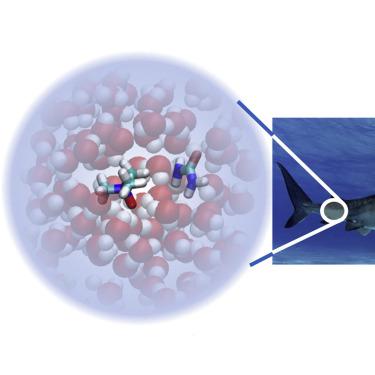Chem ( IF 19.1 ) Pub Date : 2018-09-13 , DOI: 10.1016/j.chempr.2018.08.020 Wen Jun Xie , Seoncheol Cha , Tatsuhiko Ohto , Wataru Mizukami , Yuezhi Mao , Manfred Wagner , Mischa Bonn , Johannes Hunger , Yuki Nagata

|
Trimethylamine N-oxide (TMAO) and urea are both osmolytes found in many marine animals, yet they show opposite effects in (de-)stabilizing proteins. Gaining molecular-level insights into the TMAO-urea interaction in aqueous solution is a key step in elucidating their biological roles. Here, combined ab initio molecular dynamics simulations, polarization-resolved femtosecond infrared pump-probe spectroscopy, and nuclear magnetic resonance spectroscopy reveal that the hydrophobic interaction between TMAO and urea is favorable in comparison with the hydrogen-bonding interaction. The association of the hydrophobic methyl group of TMAO with urea is driven by the large mismatch between the strong TMAO-water hydrogen bond and the weak urea-water hydrogen bond. Our observations provide a rationale for the counteraction of osmotic pressure resulting from urea by TMAO.
中文翻译:

TMAO和尿素之间较大的氢键不匹配促进了它们的疏水缔合
三甲胺N-氧化物(TMAO)和尿素都是在许多海洋动物中发现的渗透液,但它们在(去稳定)蛋白质方面显示出相反的作用。获得水溶液中TMAO-脲相互作用的分子水平的见解是阐明其生物学作用的关键步骤。在这里,从头算起分子动力学模拟,偏振分辨飞秒红外泵浦探针光谱和核磁共振光谱表明,与氢键相互作用相比,TMAO和尿素之间的疏水相互作用更有利。TMAO的疏水甲基与尿素的缔合是由强TMAO-水氢键与弱尿素-水氢键之间的巨大错配驱动的。我们的观察为TMAO抵消尿素引起的渗透压提供了理论依据。











































 京公网安备 11010802027423号
京公网安备 11010802027423号